
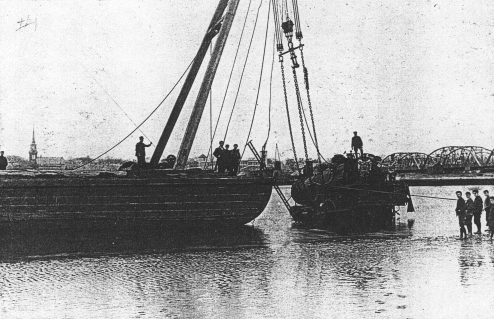
 |
 |
The tender stopped on brink of the big gap while the engine hung for a second, then took a fatal
plunge and went nose down and struck the water with a crash and roar that could be heard fully
half a mile.
It is nothing short of a miracle that the entire train was not swept into the river with most
horrible results. The engine’s beneath 25 feet of water. Fireman Winn of Portsmouth lies at
the Anna Jaques hospital where he was taken after the accident, suffering from numerous bruises
and the terrible shock of plunging through the air for 40 feet and diving to the river bottom,
and then to figure in a remarkable and daring rescue.
While none of the passengers were injured, they were badly shaken up by the sudden stop of the
train. Train number 92 hauled by engine 23 left Boston at 6 o’clock last night loaded with human
freight. Many of the passengers left before reaching this city, so that when the engine dashed
into the local depot there were less than 100 pass engers on board. The train was in charge of
Conductor Emmons Garland. Upon its arrival here, water for the engine was taken at the standpipe
near the Merrimac street bridge, and then the train slowly steamed toward the railroad bridge
where a few minues later it was to figure so prornmently in such a stirring and almost tragic
drama.
Thinking only of the dear ones they were to meet at the end of their journey, little thinking of
the narrow escape they were to experience within a few seconds, the passengers chatted and joked,
trusting in the men who watched the throttle for their safety. Why should they not hold the
sincerest faith in these veteran employes, had they not for years traveled over this road under
these men and never met with an accident. An accident, it was the last thing that entered the
minds of the young and old who constituted this load of human freight.
Slowly the engine left the water-stand and as it crawled toward the bridge more speed was given.
The train was making fast headway when it reached the bridge. Crash! With a nerve wrecking,
sickening sound, the big gates were splintered and hurled to sunder by the impact of the big
iron-horse. With thoughts of the terrible accident that seemed almost unavoidable, the fireman
and engineer had little time to think of what was ahead. With a spring the throttle was grasped
and in a second the emergency brakes were grinding and crunching against the wheels of the cars.
The train had felt the brakes. It was a terrible moment. Slower and slower each moment the iron
monster crept, snorting and puffing as though in agony to proceed. Nearer the chasm grew. The
engine must go into the river, the fireman and engineer had saved their load of human freight,
they must jump for their lives.
With a sharp snap, the coupling that held the engine and tender broke, and the engine as though
rejoicing at its liberty, suddenly leaped ahead, poised for a moment in mid-air and dove through
the inky blackness to the river 40 feet below. Fireman Winn stuck to his post and when the engine
went into the water, he was in the cab. How he freed himself none but himself can tell. The
remainder of the train stopped on the brink of the yawning gap, and the engine alone was wrecked.
Hardly had the big iron monster left the rails before hundreds of people, aroused by the crash,
were speeding toward the crossing.
When the engine struck the river, Fireman Winn managed to extricate himself from the wreckage and
stake out for shore. His presence of mind, even in this dire position, never failed him and with
shouts of Help! Help! he directed his rescuers where to throw the life line.
Captain William I. Hunt, drawtender of the Newburyport bridge, had seen the engine approach the
open draw and the great presence of mind that has served him so well in similar accidents, he
grabbed a life-preserver and dashed to the rescue. The tug Bronx, for which the draw had been
opened, had passed safely through. Drawtender Ernest Hennessey of the railroad bridge, had grabbed
a life preserver when the crash came and rushing to the edge of the pier, hurled it into the water.
The tide was fast going out and Winn floated with it. Captain Hunt heard his cries for help and
rushing to the pier, hurled his life preserver at the point from which, the sound seemed to
emanate. The cork-filled sack shot through the air and to those on the bridge was lost in the
inky dark ness of the night. To those waiting it seemed hours. Suddenly from the water came a
glad cry and the captain knew that his aim was true. The line was hauled taught and with the
assistance of Drawtender Hennessey of the railroad bridge and Assistant Drawtender Samuel
Truesdale of the footbridge, Captain Hunt rescues Winn from what looked at one time like a
waiting grave.
A large crowd of people thronged the bridge to witness the preparations. The derrick was put
in position and two divers were sent down to put the chain slings around the engine. The forward
trucks of the engine were easily hoisted out of the river and placed on the lighter and this
forenoon the preliminary work had been so far accomplished that the contractors decided that
the raising of the machine, the engine , boiler and cab intact, could be accomplished this
afternoon.
The locomotive will, when raised be held suspended from the derrick and in that position the
lighter will be deposited on the beach on Ring’s Island shore.
The big monster weighing 62 tons was handled like an infant in its mother’s arms. with the
powerful apparatus used. In the forenoon the two divers made two slings by passing chains
around the engine and then the tackle was attached to the falls of the big derrick and the
engines on the lighter started.
A crowd numbering nearly 1500 people, most of them having a fine view of the work from the
Newburyport bridge, watched with interes. Many spectators were on the wharves along the water
front.
March 25,1908 INTO THE RIVER
Boston and Maine Engine Plunges Through Open Draw.
Crashing through the gates after disregarding the signals that had been set for an open draw
on the Newburyport railroad bridge engine #23, hauling a train of four passenger cars, a freight
car and a tender dashed toward the gaping abyss last night and only for the fact that emergency
brakes were applied the entire train with its crew and passengers would have been hurled into
the deep, dark waters of the Merrimac. The engine toppled and fell and with it the fireman,
William Winn of Portsmouth. The tale of Winn’s rescue is a thrilling one.
Passengers on Portsmouth Bound Train Have a Thrilling Escape Last Evening.
Cars Stopped on the Very Brink of a Yawning Gap With Certain Death Below.
Fireman Goes Into Water With Engine.
Track Injured
When the great locomotive plunged from the bridge through the opening into the river the tracks
were somewhat twisted and repairs had to be made before trains were allowed to cross.
New Regulations
It used to be the rule of the railroad company not to open the draw for pass ing boats within
20 minutes of train time, but it is understood that the bridge has to be opened now within a
reasonable period after a tug boat has whistled.
Trains Delayed
The Flying Yankee and Pullman were delayed quite a while by the accident. The inward train was
flagged in Salisbury and the Portland bound train was stopped outside the High street bridge.
They went through at 8:35 Men worked at the bridge the greater part of the night.
Foot Note
Boston & Maine Railroad locomotive number 23 was a American class A-47-c. The 4-4-0 locomotive
was built by Rhode Island Locomotive Works 2-17-1896. The locomotive was renumbered 1110 by the
Boston & Maine Railroad in 1911. The 4-4-0 steam locomotive was scraped by the Boston & Maine
Railroad in 1926.
The 4-4-0 Americans
The Boston & Maine Railroad had more 4-4-0 American locomotives than any other type. The 4-4-0’s
were the mainstay of early motive power, performing most every task, pulling the passenger
trains, freight trains and switching service. Many of the Americans were inherited from other
railroads when the Boston & Maine purchased the Eastern Railroad and the Boston & Lowell
Railroad as well as other roads. Many of the inherited Americans just barely saw the new
numbers of 1911, before being scrapped.
Monday April 6,1908 RAISING THE Engine
Planned to Accomplish the Work at Bridge Draw This Afternoon.
The raising of the Boston & Maine locomotive from the bottom of the river will be accomplished
this afternoon, unless some unforeseen accident occur to hinder. Yesterday the steam lighter,
Esther C. arrived from Boston and was taken up between the bridges. The work was begun this
morning by contractors, the McKie Lighterage Co. of East Boston.
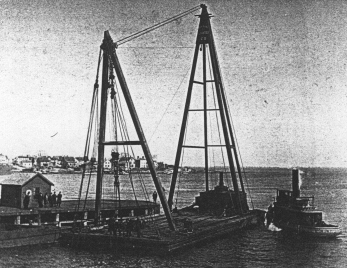 The steam lighter Esther C.at The Newbryport draw bridge
The steam lighter Esther C.at The Newbryport draw bridge
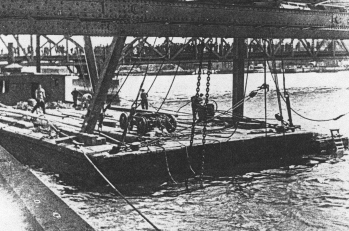 The Steam lighter Esther C. with the raised forward trucks of Loco $23
The Steam lighter Esther C. with the raised forward trucks of Loco $23
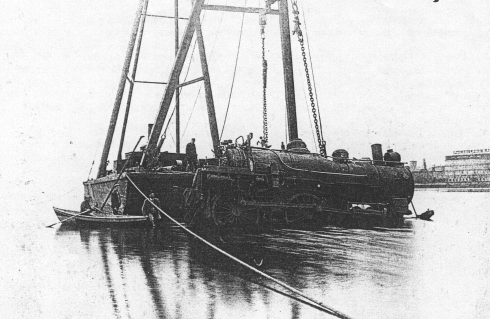 Here the engine will be righted and then taken to the P.& R. coal pocket wharf and placed on
the tracks. The whole thing will be handled easily and will be interesting to the hundreds of
spectators on hand to watch work.
Here the engine will be righted and then taken to the P.& R. coal pocket wharf and placed on
the tracks. The whole thing will be handled easily and will be interesting to the hundreds of
spectators on hand to watch work.
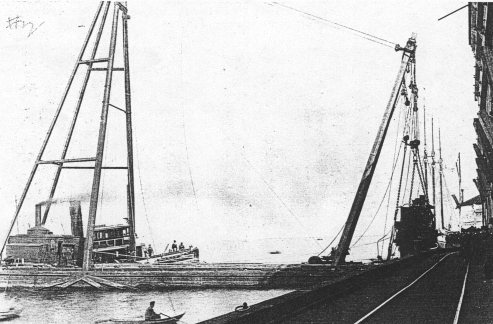 This afternoon as high tide which is about 4 o’clock, the lighter with the engine still trailing
in the water was pulled over to this side to the coal pocket wharf. Here the it was raised up
and swung onto the tracks of the City Railroad.
This afternoon as high tide which is about 4 o’clock, the lighter with the engine still trailing
in the water was pulled over to this side to the coal pocket wharf. Here the it was raised up
and swung onto the tracks of the City Railroad.
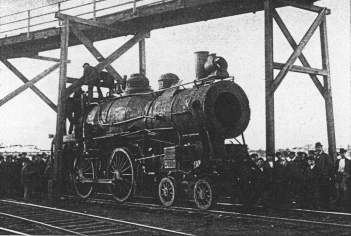 Boston and Maine Loco #23 on the spur tracks of Newburyport City Railroad
Boston and Maine Loco #23 on the spur tracks of Newburyport City Railroad
![]()
Home / Who We Are / History / Events / Express Gifts / Photo Archive / Links / Contact Us © 2002 Salisbury Point Railroad Historical Society